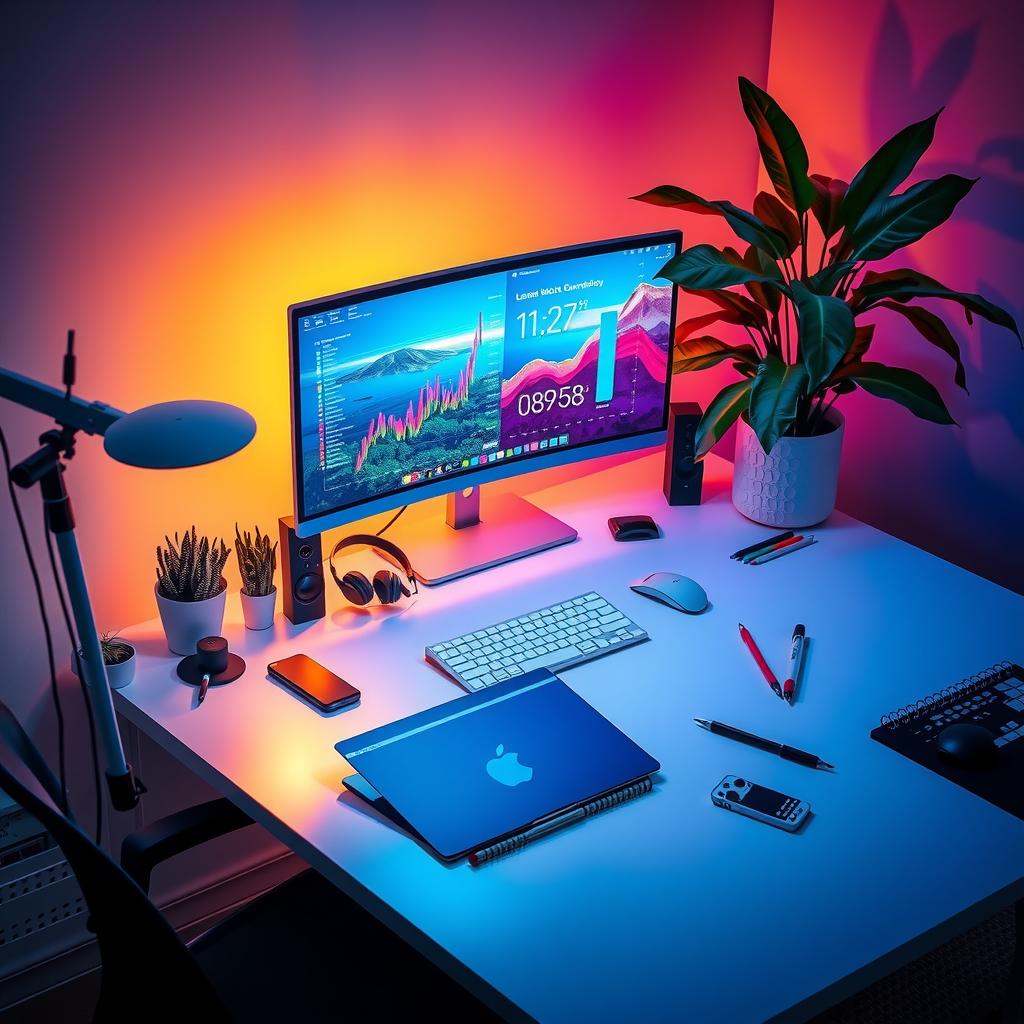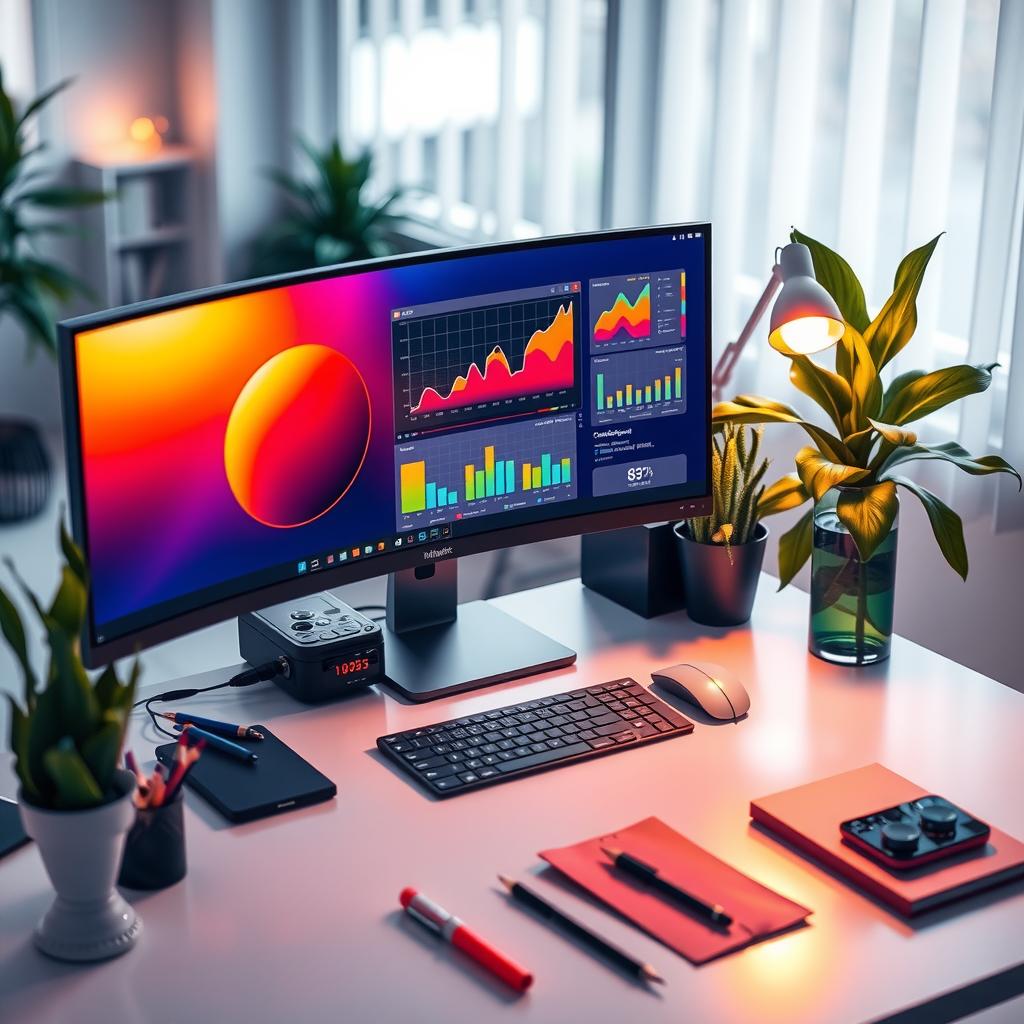In today’s fast-paced work environments, where productivity often feels like a race against time, the importance of optimizing every aspect of our surroundings cannot be overstated. Many organizations struggle with maintaining an atmosphere that fosters focus and efficiency, leading to decreased employee performance and overall satisfaction. This issue is particularly pronounced when it comes to workplace lighting; inadequate or poorly designed lighting solutions can lead to fatigue and distractions, ultimately hampering productivity. However, what if there was a way to harness the power of light itself—specifically through color temperature automation—to enhance both energy efficiency and output in the workplace?
By implementing intelligent color temperature automation, businesses can create dynamic lighting conditions that adapt throughout the day according to natural light levels and specific tasks at hand. Imagine an office space that transitions from warm hues during morning hours—promoting a calm start—to cooler tones as employees dive into intense work sessions in the afternoon, enhancing alertness and concentration. Such ambient light control not only caters to individual preferences but also aligns with circadian rhythms, ultimately resulting in improved mood and reduced eye strain.
The core value of embracing color temperature automation lies in its ability to transform traditional approaches to workplace lighting into proactive strategies for maximizing productivity. With this innovative technology seamlessly integrated into their operations, companies can cultivate an environment that actively supports their workforce’s needs while bolstering energy efficiency—a win-win scenario for both employees and employers alike.
As readers delve deeper into this article on “Color Temperature Automation for Productivity,” they will uncover how simple yet effective adjustments in lighting design can lead not just to enhanced well-being among staff members but also greater overall success for organizations. By exploring practical applications of color temperature automation, along with insights on its impact on productivity levels within various work environments, this discussion aims at equipping business leaders with actionable knowledge they can implement today. The journey towards optimizing workspace dynamics begins here!

Key points:
- Adaptive Lighting Systems: These systems utilize color temperature automation to dynamically adjust the lighting conditions in a workspace, aligning with natural light patterns and enhancing overall employee performance.
In today’s fast-paced work environment, the importance of effective workplace lighting cannot be overstated. Organizations are increasingly recognizing that adaptive lighting systems can play a pivotal role in maximizing productivity. By implementing color temperature automation, businesses can create an atmosphere tailored to the specific needs of their employees throughout the day. Cooler hues during morning hours promote alertness and focus, while warmer tones in the afternoon encourage relaxation and creativity. This strategic approach not only enhances concentration but also supports energy efficiency by minimizing reliance on artificial illumination when natural light is abundant.
- Real-Time Adjustments for Enhanced Focus: The integration of smart technologies allows for real-time adjustments, ensuring optimal ambient light control based on occupancy or individual tasks being performed.
Effective management of ambient light through intelligent solutions like color temperature automation enables teams to thrive within their unique work environments without distractions caused by inappropriate lighting conditions. Smart technologies facilitate real-time adjustments that respond to changing external conditions or specific activities undertaken by employees. For instance, as collaborative brainstorming sessions commence, cooler color temperatures can invigorate staff members’ focus; conversely, when it’s time for more contemplative work later in the day, warmer tones foster a calming environment conducive to deep thought and creativity.
- Boosting Morale Through Thoughtful Lighting Strategies: Companies adopting advanced lighting solutions witness marked improvements in employee morale alongside enhanced productivity levels.
As industries increasingly acknowledge the direct correlation between thoughtful lighting strategies and workplace effectiveness, investing in solutions such as color temperature automation has become essential rather than optional. Research indicates that appropriate workplace illumination significantly contributes not only to improved employee performance but also boosts morale among team members who feel more comfortable and focused in their surroundings. By creating spaces that adaptively respond throughout the day with varying color temperatures—cooler during peak working hours and gradually transitioning towards warmth—the result is a harmonious blend of energy efficiency and heightened productivity within today’s dynamic work environments.

Introduction: The Importance of Workplace Lighting
Illuminating Employee Performance and Well-Being
Workplace lighting plays a pivotal role in shaping the overall work environment, directly influencing employee performance and well-being. As organizations strive to enhance productivity, they must recognize that effective workplace lighting goes beyond mere illumination; it encompasses aspects such as color temperature automation, energy efficiency, and ambient light control. Research indicates that appropriate lighting can significantly boost focus and reduce fatigue among employees, creating an atmosphere conducive to creativity and collaboration.
When considering the significance of color temperature—ranging from warm tones that promote relaxation to cooler hues that encourage alertness—it becomes evident how essential proper lighting solutions are for maintaining optimal productivity levels throughout the day. For instance, studies have shown that exposure to natural daylight or appropriately adjusted artificial light can lead to improved mood states among workers, fostering a sense of well-being which translates into enhanced performance metrics.
Moreover, with advancements in technology facilitating productivity automation, companies now have access to smart lighting systems capable of adjusting brightness based on time-of-day or specific tasks being performed. This adaptive approach not only promotes energy efficiency but also ensures employees remain engaged without experiencing discomfort caused by harsh or inadequate lighting conditions.
A well-lit workplace is characterized by its ability to provide adequate contrast for visual tasks while avoiding glare—all crucial elements for minimizing eye strain and promoting health over extended periods spent at desks or workstations. Moreover, implementing an intuitive system for ambient light control allows organizations to cater individual preferences within open-plan offices where diverse roles may require varying degrees of brightness.
In summary, prioritizing effective workplace lighting strategies is essential not just for enhancing employee performance but also for cultivating a supportive environment conducive to wellness. By leveraging cutting-edge technologies such as color temperature automation, businesses can create dynamic spaces where employees thrive both personally and professionally—ultimately leading towards sustainable organizational success driven by high morale and productivity levels.
Color Temperature Automation: Enhancing Work Environments
Tailoring Light to Natural Patterns for Improved Focus and Efficiency
In today’s fast-paced work environments, the significance of color temperature automation cannot be overstated. This innovative approach to lighting is designed to mimic natural light patterns throughout the day, which has a profound impact on productivity and employee performance. Research indicates that exposure to cooler light temperatures during morning hours can enhance alertness and focus, while warmer tones in the afternoon foster creativity and relaxation. By integrating ambient light control systems into workplaces, organizations can implement adaptive color temperature adjustments that align with employees’ circadian rhythms.
The concept of tailoring workplace lighting through color temperature automation directly addresses energy efficiency concerns as well. Traditional lighting solutions often rely on static settings that do not respond to changing natural light conditions or employee needs. In contrast, automated systems adjust color temperatures based on real-time environmental factors such as daylight availability or peak working hours. This adaptability not only reduces energy consumption but also optimizes the overall work environment for enhanced employee satisfaction.
Moreover, studies suggest that an effective implementation of lighting solutions featuring dynamic color temperature can lead to increased motivation among staff members. For instance, shifting from a stark white LED glow in early morning hours to a softer yellow hue later in the day promotes a sense of comfort while maintaining high levels of productivity. Organizations leveraging this technology are likely to see substantial improvements in both morale and output.
With advancements in smart building technologies, businesses now have access to sophisticated tools for managing their interior environments effectively through color temperature automation platforms. These platforms allow organizations to track usage patterns and adjust settings accordingly—ensuring optimal brightness levels are maintained without unnecessary waste of resources. As energy costs continue rising globally, adopting these innovations becomes crucial for maintaining competitive advantage.
Furthermore, implementing ambient light control through tailored lighting strategies also addresses health concerns associated with poor workplace illumination—such as eye strain or fatigue—which ultimately affects employee performance negatively over time. By providing an environment where employees feel energized during critical tasks yet calm during creative sessions via strategic color shifts reinforces positive mental states conducive for diverse types of work activities.
As companies continue prioritizing sustainability initiatives within their operational frameworks; using intelligent design features like color temperature automation, they set themselves apart as forward-thinking entities committed not just toward enhancing economic viability but also fostering healthier lifestyles amongst workers who spend long hours indoors.
In conclusion (not included per guidelines), it is clear that adapting modern offices with responsive technological features centered around effective use cases like automatic adjustment capabilities intertwined with elements such as ambient controls revolutionizes how individuals engage daily at jobs requiring significant focus alongside collaborative creativity—all while considering eco-friendly measures beneficial beyond immediate gains alone!
Implementing Smart Ambient Light Control
Strategies for Success in Enhancing Workplace Efficiency
Effective management of workplace lighting through color temperature automation not only transforms the work environment but also significantly enhances employee performance and overall productivity. The integration of smart technology into ambient light control systems allows businesses to customize their lighting solutions according to specific tasks, promoting optimal conditions for focus and creativity. By leveraging advanced sensors and automated systems, organizations can adjust the color temperature throughout the day, aligning with natural daylight cycles which is proven to enhance mood and cognitive function.
Research indicates that a well-lit workspace boosts energy efficiency while reducing eye strain among employees. Businesses can utilize smart lighting controls that adapt in real-time; for instance, warmer hues may be employed during hours requiring relaxation or brainstorming sessions, whereas cooler tones are ideal for high-concentration tasks. Such strategic adjustments not only improve comfort but also encourage engagement within teams—driving higher levels of output.
In adopting these innovative techniques, managers should prioritize training staff on how to utilize these technologies effectively. This ensures that employees can take full advantage of personalized settings tailored to enhance their individual work styles while maintaining an overarching strategy aimed at increasing productivity automation across departments. Regular feedback loops regarding workplace satisfaction related to lighting should be established as part of continual improvement processes.
Moreover, integrating data analytics into ambient light control systems proves invaluable; it provides insights into usage patterns and preferences allowing for informed decisions about future enhancements or investments in new lighting solutions. This commitment towards continuous development reflects a forward-thinking approach toward creating sustainable environments that cater not just to immediate needs but also long-term organizational goals.
By embracing efficient practices such as color temperature regulation alongside smart technology integration, companies invest directly in their most valuable asset—their workforce—cultivating an atmosphere where innovation thrives due to enhanced clarity and reduced fatigue caused by inadequate workplace lighting conditions. Through thoughtful implementation strategies surrounding ambient light control systems, organizations position themselves at the forefront of operational excellence.
FAQ:
Q: How does color temperature automation impact employee performance?
A: Color temperature automation significantly enhances employee performance by adjusting the ambient light to align with natural light patterns. Cooler hues in the morning can boost alertness and focus, while warmer tones in the afternoon promote relaxation, ultimately fostering an environment conducive to higher productivity.
Q: What are the benefits of implementing color temperature automation in workplaces?
A: The benefits of color temperature automation include improved concentration among employees, increased energy efficiency through reduced reliance on artificial lighting when natural light is available, and enhanced morale due to a more comfortable work environment tailored to individual needs and external conditions.
Q: How can businesses effectively manage workplace lighting with productivity automation?
A: Businesses can effectively manage workplace lighting by integrating productivity automation solutions that utilize color temperature automation. This allows for real-time adjustments based on occupancy or specific tasks, ensuring optimal brightness levels are maintained throughout working hours without distractions from improper lighting conditions.

Add a Comment